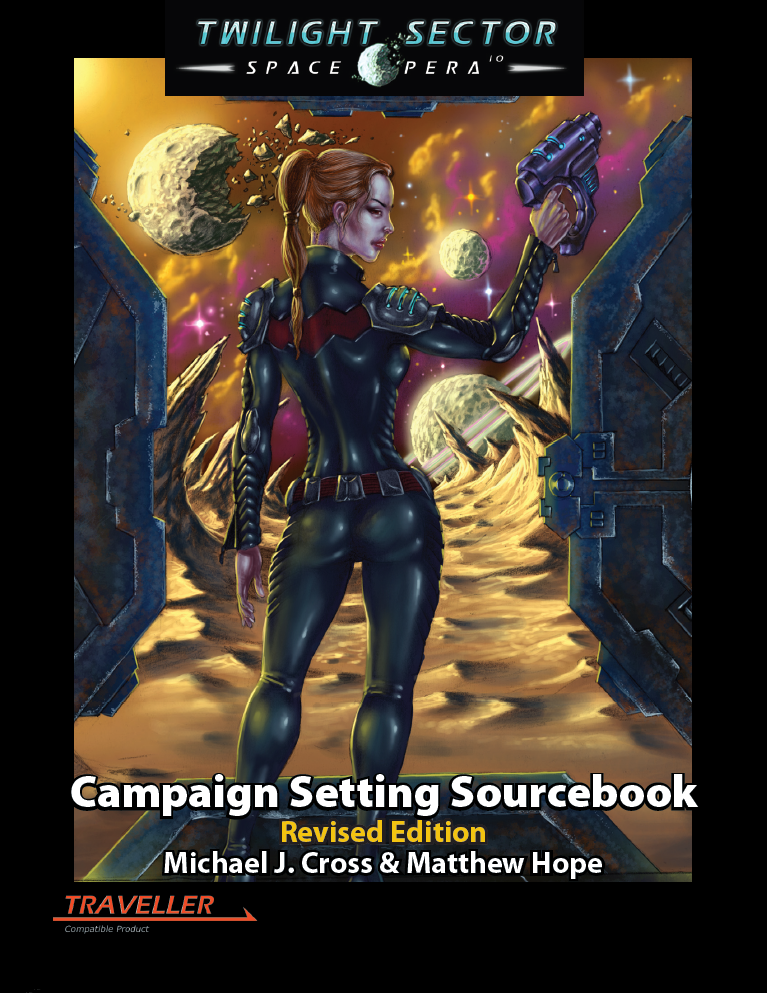Twilight Sector Campaign Setting Sourcebook, Revised Edition
Editor’s Note: This article originally appeared in Freelance Traveller’s June 2011 issue.
 Twilight
Sector Campaign Setting Sourcebook Revised Edition. Michael J. Cross and
Matthew Hope
Twilight
Sector Campaign Setting Sourcebook Revised Edition. Michael J. Cross and
Matthew Hope
Terra/Sol Games: http://www.terrasolgames.com
120pp, softcover
US$19.99
I reviewed the original edition of this Traveller OGL product when it first came out. Now that the second edition of their setting has been released, I was anxious to go back and see what they had done with the second edition. My first impression was “They Listened To Me!”
[Editor’s Note: Richard’s original review appeared in the January 2010 issue of our magazine.]
Rather than just review the changes to this product, I am going to redo my review completely. The Twilight Sector is a setting for use with the Traveller rules published by Mongoose Publishing. This setting has a very Transhuman feel. Characters can be Mainline Humans, Scientifically Induced Mutants (SIMS), Natural Mutants (NM), Uplifted Animals or possibly Artificial Intelligences (AI). The writers use the Alien Traits presented in the TMB as a baseline for developing their mutations, which I feel works very well and is quite inspired. Mainline humans can live up to 300 years of age. There is a nice discussion of how to develop and play one of these Centennials. This information was added with the second addition and is well done.
The history is interesting and seems to logically lead to the setting as presented; the current year is 2991. There is a nice map of the entire setting showing all the major polities out to the edge of known space. There doesn’t seem to be any regions on the map that are not controlled by one of the great powers. Even the OTU had regions with a lot of independent worlds. This setting doesn’t seem to have such an area, although many of the regional powers are loose confederations or unions that have a lot of variation within their membership.
There are no aliens in the setting, although alien ruins have been found. This leaves things open to the Referee or to future development by Terra/Sol Games. From the hints given in the book it looks like the writers have something in mind.
The Twilight Sector itself is actually a subsector. Only six of the worlds are mapped and detailed. The rest of the map is blank; not even stars are shown. The second edition of the rules identifies regions of the sector to be developed later by Terra/Sol games. The detail of the worlds was very good, several plot hooks are available in every system and there are nice world maps and system maps. But again, while this is the edge of the explored, none of the unexplored is even shown. Referees are free to develop new systems for exploration, but Terra/Sol has plans for about 1/3 of the sector.
The setting also uses a variation of the Jump Drive called the Transluminal Drive which treats the jump number as speed rather than range and it also uses FTL radio that travels at the same speed as the ships. This is different and interesting, but no other explanation is given about ship design and no sample ships are included. There is some discussion about how Jump-8 is possible, but since nothing in the TMB rules allow more than a rating of 6, it leaves a hole in designing ships for the setting. Future products showing ship designs are expected. Throughout the text there is mention of city-sized ships called Dreadnaughts. No information is actually provided about them, such as where they go (or don’t go), how many other ships they can carry, how big they actually are in tons. While this leaves a lot of room for the Referee to develop these behemoths, I hope that future products explore them or at least give us some more details. I would imagine a multi-megaton ship arriving at your planet would have a very significant affect on the economy.
The primary world in the Twilight Sector is Terra/Sol, an exact duplicate of Earth, down to the shape of the continents. Obviously this is one of the big mysteries of the setting. Terra/Sol represents a nice alternate to Earth: alternate countries (Aztec Empire, Republic of the Plains etc). Countries in the North American continent are described along with a description of their borders. No geopolitical map of Terra/Sol is provided however and countries outside of North America are hinted at, but not described.
The artwork is very good overall. There some color pictures, shaded pictures and line drawings; a nice variety of artwork. There are only a few obvious typos, and none that really confused you. Several of the tables were poorly formatted in the original version and this has been cleaned up in the second edition.
While my original review was very mixed, I really like what was done with this revised edition. All of the areas that I felt were missing have at least been addressed and what was there to begin with was very good. Originally, I gave this book a 3 out of 5 star rating, however, I feel this second edition deserves a solid 5 out of 5 stars. For $12 (PDF), it is well worth the price.
Rating: 5 out of 5 Stars
 Freelance
Traveller
Freelance
Traveller